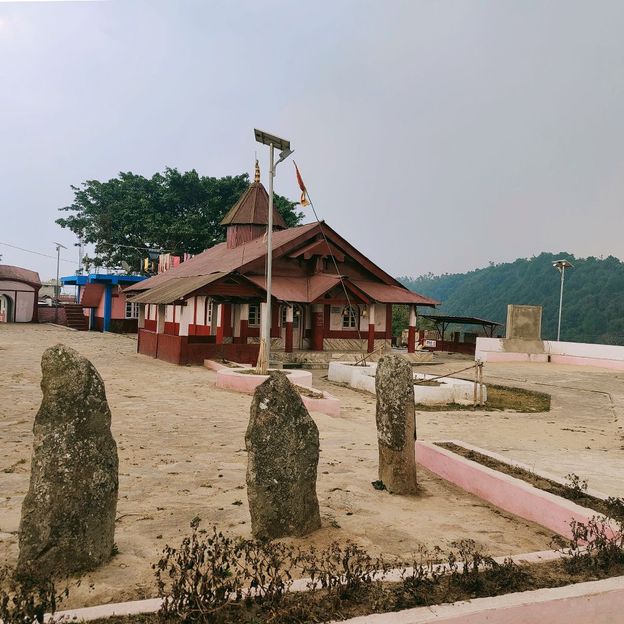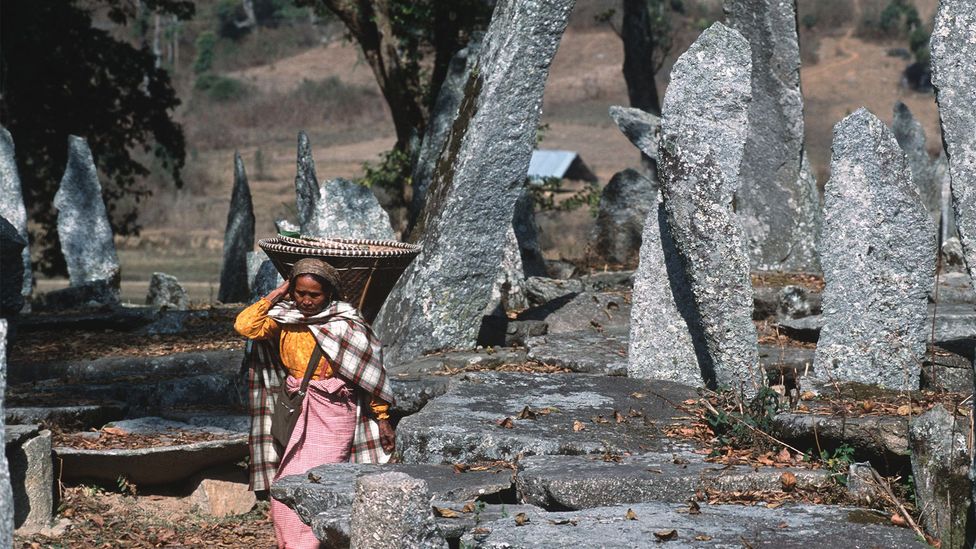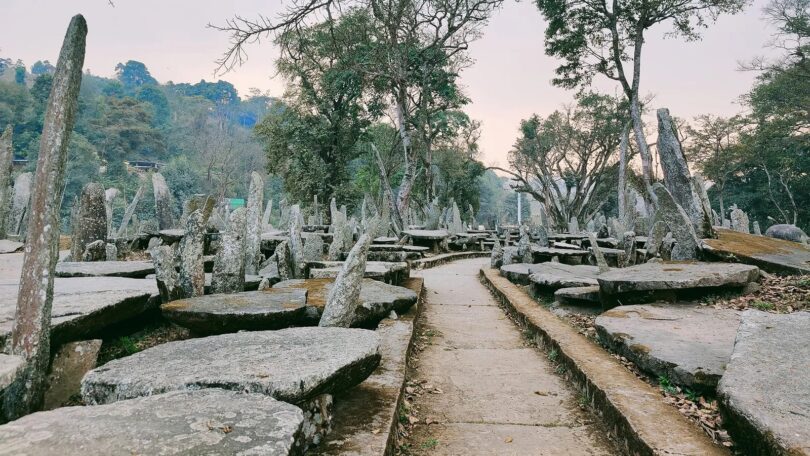Satarupa Paul
It was a stroke of luck that brought me to the monoliths of Nartiang in Meghalaya on a February afternoon. Up until a decade or so ago, India’s north-east, including the state of Meghalaya was considered too remote for most travellers. Today, it’s one of the nation’s most sought-after destinations, so much so that a deluge of tourists often creates unprecedented traffic situations, as on that afternoon.
My family and I had set out on a day trip from state capital Shillong to Cherrapunji, a town known for being one of the wettest places on Earth. However, the serpentine queue of cars that was also headed there and to other popular destinations such as Dawki and Mawlynnong budged inch by inch, testing our patience with every passing minute. After being stuck in traffic for more than four hours, a suggestion was made to double back to the city as a last-ditch attempt to save whatever remained of the day. A quick online search revealed other must-visit spots in the vicinity of Shillong. Most were familiar, but one intriguing new name emerged.
“Visit Nartiang for its mysterious monoliths,” one listicle mentioned, playing up the “mysterious” angle with an eerie-looking photo of tall stones huddled together while failing to furnish any further details. Google Maps came to the rescue; the place was barely two hours south of Shillong and the route was devoid of traffic too.
That is how I found myself standing in the shadow of the giant monoliths of Nartiang. While similar structures, roughly carved from single blocks of granite into upright pillars or horizontal slabs, are found at locations throughout Meghalaya, Nartiang is home to the densest and largest collection in the region.
As we entered the site, I could see several hundred monoliths of all sizes packed on a small hillock, some lying prostate, others rising tall and vying for attention alongside huge trees. A perpetual mist hung about the place, adding to the air of mystery.
The site was unmanned and there was only a dusty signboard to provide information. Among the few facts listed, one grabbed my attention: “The tallest menhir is 8 metres high and 18 inches thick and according to Jaintia legend was erected by a giant named Mar Phalyngki.”
My curiosity piqued, I wanted to know more about the stones. But the place was empty apart from a bunch of kids playing football in an adjoining park. However, later that day I met a village elder named Maryo Symblai who told me the story of the monoliths that has been orally passed down over generations.
“Back in the day, Nartiang didn’t have a bazaar and the nearest one was at Raliang,” she said. “On one such bazaar day, a Jaintia giant named Mar Phalyngki was caught in torrential rain on his way back. He requested to borrow an umbrella from the Raliang chief’s youngest daughter, but she wanted to test his legendary strength instead. ‘Why don’t you go lift that huge stone in the bazaar and use it as an umbrella?’ she teased. Emboldened by her challenge, he did just that, but before reaching Nartiang, he placed it in a forest when the rain had ceased.”
The anecdote that Symblai narrated sounded more fiction than fact to my untrained ears. “Our ancestors weren’t the average 5ft-something Meghalaya men of today; they were quite the giants back then,” she added earnestly, noticing the look of incredulity on my face. “Mar Phalyngki was known to be 7ft tall and was a Syiem (chieftain) of the Mars (an honorary title granted to strong, powerful and honest statesmen).”

The site was unmanned and there was only a dusty signboard to provide information (Credit: Satarupa Paul)
But how did so many monoliths come to be in one place, I asked? According to Symblai, people passing by the stone could hear noises like that of a thriving marketplace. It was decreed that the stone was sacred, and that the forest around it be cleared for a bazaar. More such monoliths were brought in to beautify the place, resulting in the large collection seen today.
The folktale made it clear that these ancient monoliths have long been of great importance to locals. Eager to know more, I started researching both the Jaintia people and the stones.
The Jaintiapur kingdom was a matrilineal kingdom that extended from the province of Sylhet in present-day Bangladesh to the hills of Meghalaya, and their people were believed to have been exceptionally tall and strong, although no official evidence exists. Given its cool climate and ideal location in the hills, Nartiang served as the summer capital of the Jaintiapur kingdom and the monoliths are believed to have been erected during their reign between 1500 CE and 1835 CE.
According to Dr Vinay Kumar, assistant professor in the Department of Ancient Indian History, Culture & Archaeology at Banaras Hindu University, the monoliths in Meghalaya including Nartiang may have served as megalithic tombs. “The Khasi and Jaintia people of Meghalaya and the Nagas of Assam erected single standing stones or alignments of stones in honour of the dead,” he wrote in The Tribal Tribune, an online academic publication focussed on India’s tribal communities.
Before the advent of Christianity in the early 19th Century under British rule, most of the Jaintias were Hindu, which meant that their departed were cremated. The ashes of the deceased were taken by clan members, and according to Kumar, deposited in a free-standing cist (an ancient burial chamber) built of enormous single stone slabs, some as big as a small house. Those structures remain today as the monoliths of Nartiang, Cherrapunji, Jowai, Maoflong and Lailugkot, he wrote.
The flat horizontal stones, or dolmens, were meant for women, while the upright ones, or menhirs, were for men. “Yet, Nartiang remains a curious case, for there’s no concrete proof of how and why such a large concentration of these monoliths came to be present in one place,” said Samuel Sawian, who runs a travel company offering offbeat experiences focused on the history and heritage of Meghalaya.

The flat horizontal stones, or dolmens, were meant for women, while the upright ones, or menhirs, were for men (Credit: Thierry Falise/LightRocket via Getty Images)
“Possibly, the tallest stone was erected for someone important in the clan, and the rest were added for other members over a few generations. The site progressively became a marketplace, and the stone slabs were used as stalls to display and sell wares or to sit on and rest,” he said.
The monoliths continued to play an important role in Jaintia society, even after the kingdom began to lose its power with the advent of colonial rule.
In the early 1800s, after establishing its foothold in Bengal, the British East India Company was eager to expand its land revenue areas. They began exploring regions farther east and came upon the Jaintiapur kingdom in Sylhet. In their attempts to gain control of the territory, the British exiled the Jaintiapur raja (king) to the hills in the north in 1835. The raja chose his summer capital Nartiang deep in the northern hills as his new seat of power and continued his political affairs from there.
“Nartiang’s political importance grew once the Jaintia king was forced to abdicate his seat in the Sylhet plains. The area with the monoliths too gained prominence for different activities, such as the coronation of rajas or for conducting judicial and administrative deliberation,” said Dr Reeju Ray, a historian and author of Placing the Frontier in British North-East India. “It thus appears that the Nartiang monoliths may have had some political significance too.”
Even though the folktales surrounding the Nartiang monoliths sound fantastical, it’s evident that these structures served real purposes through the ages.
“There is a certain overlap of myth and memory in the case of the Nartiang monoliths. The locals’ account of how the place came to be is based in myth or folklore. But they also remember it for the purpose it served their ancestors – as a weekly marketplace, a memorial, a place for political gatherings. That is how oral history works, it blends fact and fiction into collective memory,” Ray said.
Today, the Nartiang monoliths serve no purpose except to stand as towering relics from a time gone by. Detailed archaeological work is yet to be carried out to explore the exact whys and hows of the site. Even though the folklore and more substantiated historical accounts offer some insight to the site, the mystery of the stoic stone giants lingers on.
Courtesy: BBC







